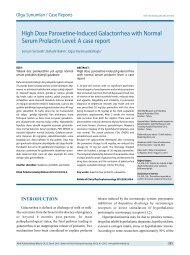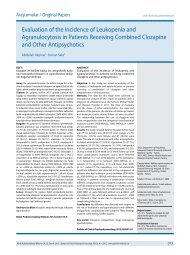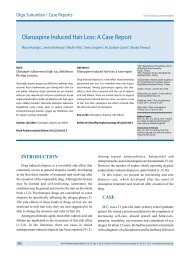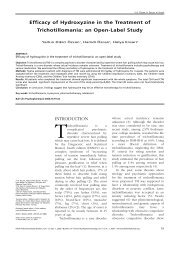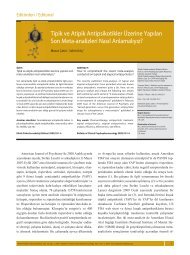Depression and Cardiovascular Disease: The Need for Improved ...
Depression and Cardiovascular Disease: The Need for Improved ...
Depression and Cardiovascular Disease: The Need for Improved ...
You also want an ePaper? Increase the reach of your titles
YUMPU automatically turns print PDFs into web optimized ePapers that Google loves.
<strong>Depression</strong> <strong>and</strong> cardiovascular diseases: the need <strong>for</strong> improved case definition<br />
symptoms in poorer cardiovascular outcomes, there is<br />
insufficient evidence in the literature that treatment of<br />
depressive symptoms alters cardiovascular outcomes.<br />
In the SADHART study, Glassman et al. (5) evaluated<br />
the safety <strong>and</strong> efficacy of the use of sertraline on patients<br />
admitted to hospital <strong>for</strong> recent myocardial infarction or<br />
unstable angina with major depression. Although they<br />
were able to demonstrate that the use of sertraline was safe<br />
in this population, there were not statistically significant<br />
decreases in Hamilton <strong>Depression</strong> (HAM-D) scores in<br />
sertraline-treated patients as compared to placebo. Subgroup<br />
analysis did demonstrate that patients with a<br />
previous history of depression showed a statistically<br />
significant response to sertraline. When they compared the<br />
incidence of severe cardiovascular events in the sertralinetreated<br />
group (14.5%) versus the placebo group (22.4%)<br />
they were unable to find statistical significance. So<br />
although sertraline was effective in treating depressive<br />
symptoms in a recurrent depression sub-group post<br />
myocardial infarct, they were unable to show an impact<br />
between groups in cardiovascular outcomes.<br />
<strong>The</strong> ENRICHD study (6) compared a cognitive<br />
behavioural therapy (CBT) intervention in patients<br />
admitted with acute myocardial infarction who fulfilled<br />
criteria <strong>for</strong> major or minor depression or low perceived<br />
social support as compared to a usual care group. A total<br />
of 2,481 subjects were r<strong>and</strong>omized to either the CBT<br />
intervention or usual care group. Within the intervention<br />
group, if patients had scores on the Hamilton Rating Scale<br />
<strong>for</strong> <strong>Depression</strong> (HAM-D) greater than 24 or failed to have<br />
a 50% reduction in Beck <strong>Depression</strong> Inventory (BDI)<br />
scores after five weeks of intervention, they were referred<br />
<strong>for</strong> consideration of antidepressant add-on treatment<br />
(sertraline>other SSRIs>nortriptyline). Antidepressant<br />
use reached 20.6% <strong>and</strong> 28% in the usual care <strong>and</strong><br />
intervention groups respectively. Although the intervention<br />
in this study decreased depressive symptoms <strong>and</strong> improved<br />
social support as compared to the usual care group, it did<br />
not affect the primary end points of death <strong>and</strong> non-fatal<br />
myocardial infarction. <strong>The</strong> trend was again to see a<br />
reduction in reinfarction <strong>and</strong> mortality in patients on<br />
antidepressant therapy. <strong>The</strong> authors, however, concluded<br />
that given their design study this finding may have been<br />
related to a pharmacodynamic effect of SSRIs, such as<br />
platelet inhibition, rather than to an improvement in<br />
depressive symptoms.<br />
Honig et al. (7) opted to study the effects of a dual<br />
acting antidepressant, mirtazapine, to evaluate its safety<br />
<strong>and</strong> efficacy in depressed patients post-myocardial<br />
infarction. Ninety-one patients who met criteria <strong>for</strong> major<br />
or minor depressive disorder were r<strong>and</strong>omized to either<br />
placebo or mirtazapine treatment <strong>and</strong> were followed <strong>for</strong> 24<br />
weeks. Using a last observation carried <strong>for</strong>ward model, the<br />
authors did not find a statistically significant difference in<br />
mirtazapine versus placebo in either the acute phase (8<br />
weeks) or the entire treatment phase (24 weeks) using the<br />
primary measure of reduction in HAM-D score. Statistical<br />
significance was, however, found when the authors<br />
compared the efficacy of mirtazepine on the secondary<br />
outcome measures of scores on the BDI, the depression<br />
subscale of the Symptom Checklist 90(dSCL-90) <strong>and</strong> the<br />
Clinical Global Impression (CGI). Mirtazapine was also<br />
shown to be safe in this post-myocardial infarction<br />
population, although, as in the SADHART study,<br />
medications were not prescribed until 3 months after the<br />
incident event. <strong>The</strong> authors speculate that including major<br />
<strong>and</strong> minor depression may have influenced the statistical<br />
significance of their findings on their primary outcome<br />
measure. This reflects one of the major limitations in most<br />
of the depression <strong>and</strong> cardiovascular literature, which is<br />
that the operational <strong>and</strong> inclusion criteria <strong>for</strong> defining <strong>and</strong><br />
measuring depression <strong>and</strong> depressive symptoms are<br />
inconsistent. It is plausible that the rating scales used as<br />
outcome measures are distinct in how they identify <strong>and</strong><br />
track depressive symptoms post acute coronary syndrome.<br />
<strong>The</strong>re is some debate as to why depressive symptoms<br />
post-myocardial infarction do not respond to antidepressant<br />
therapy or psychological intervention as expected when<br />
compared to a “healthy” depression population. <strong>The</strong>re<br />
seems to be some distinction in response between patients<br />
with a previous history of major depressive disorder <strong>and</strong><br />
patients who develop incident depressive symptoms post<br />
myocardial infarction (8). Similarly, the failure to show,<br />
that treating depressive symptoms improves cardiovascular<br />
outcomes promotes reflection on the etiology <strong>and</strong> biologic<br />
underpinnings of these depressive symptoms. One of the<br />
challenges in studying underlying pathophysiologic<br />
mechanisms lies in the inherent heterogeneity of subjects<br />
who meet the DSM-IV criteria <strong>for</strong> major depressive<br />
disorder. Patients meeting the criteria <strong>for</strong> depression often<br />
have a wide variance in symptom severity <strong>and</strong> symptom<br />
expression that likely represents important sub-types.<br />
8 Klinik Psikofarmakoloji Bülteni, Cilt: 21, Sayı: 1, 2011 / Bulletin of Clinical Psychopharmacology, Vol: 21, N.: 1, 2011 - www.psikofarmakoloji.org



